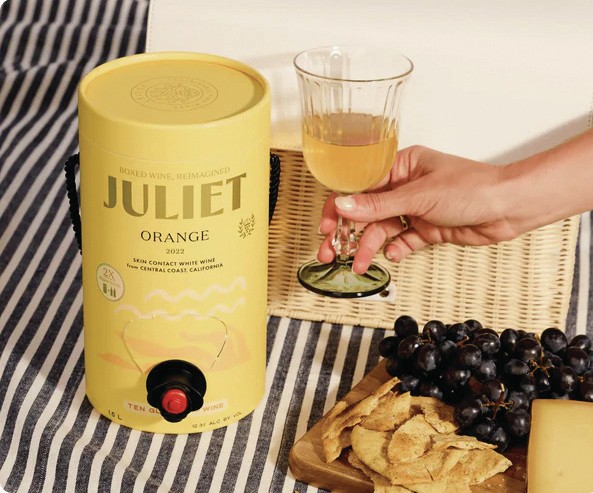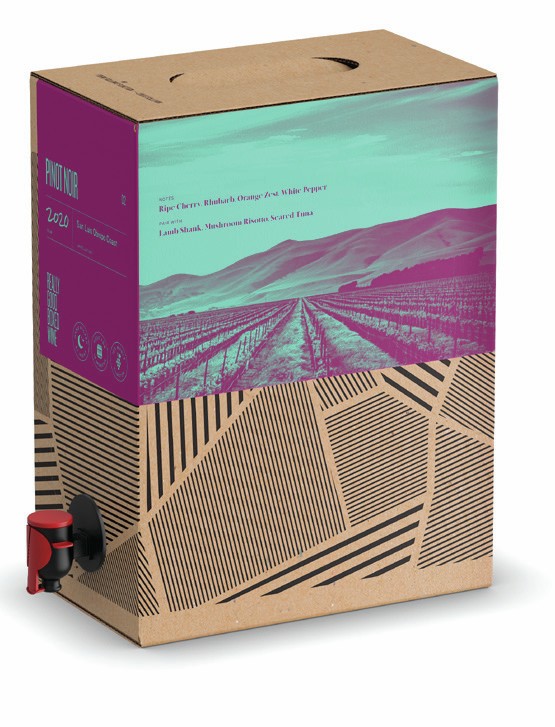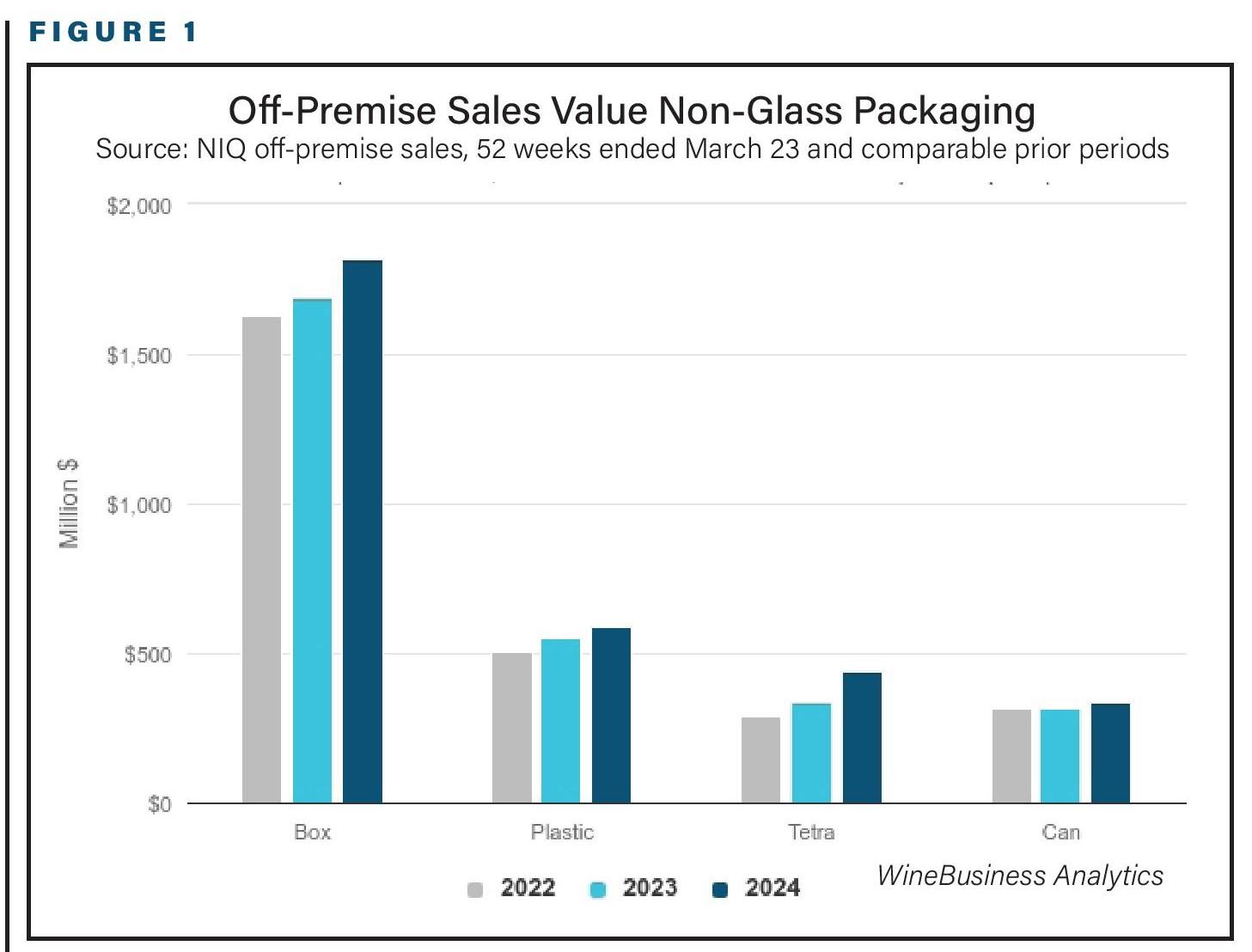



At a climate conference in New York, Melissa Monti Saunders, CEO and founder of Communal Brands as well as a consulting winemaker who specializes in producing alternatively packaged wines, pulled together an informal tasting with some attendees, members of the trade and producers. Her goal? Demonstrate that high-quality wines can be found in a variety of formats.
It worked. Participants were excited to taste bag-in-box, canned and tetra pouch wines that could hold their own against any traditionally botted wines.
As a bonus, several of the producers realized that it was the first time they had ever been in the same room as each other and had the chance to talk about some of the challenges they have faced with their alternative package brands.
“We’re all having the same frustrations about the misperceptions about the format, and we were all battling it in our own ways,” said Juliet Wines co-founder Allison Luvera. “We thought, ‘Wow, if we band together and we’re sharing knowledge and we are really raising awareness around why this format is so great together, it’s going to be more impactful than if we’re each doing it in a silo.”
She and the other producers created a new alliance dedicated to broadening perceptions of the various formats by making it simpler for producers to find reliable information and work together.
The Alternative Packaging Alliance (APA) is made up of seven founding wine brands: Juliet, Ami Ami, Really Good Boxed Wine, Giovese Family Wines, Nomadica, Communal Brands and Tablas Creek Vineyards. All the brands involved are passionate about shifting the culture of wine away from glass bottles and towards easy-to-enjoy formats for everyday occasions, and all believe in the old adage that a rising tide floats all boats.
“That’s very much our point of view with banding together like this, which is a bit unconventional because, technically speaking, some of us are competitors,” said Luvera. “Because we’re expanding a category that is already huge and pretty unsaturated, it doesn’t really feel like competition because I do think there’s room for all of us and we all have very different styles and value propositions and price points.”
Luvera makes a good point. Boxed wine, as a category, is doing well despite headlines that wine sales are sluggish. Sales value and volume for boxed wine are up in 2024 (FIGURE 1), though canned wine volume decreased, according to NIQ off-premise sales in the 52 weeks ending March 23, 2024. The average price per 750 ml for boxes is up as well, reaching $4.07 in 2024 as compared to $3.82 in 2023 and $3.70 in 2022.
Members of the APA span a variety of price points, but they are looking to prove that boxed wine isn’t just for the low-end, high-volume sector. It’s a lofty goal, and one that will certainly prove challenging. Consumers might start to appreciate the format, but convincing the trade? It’s not so simple.
On March 27, 2024, a headline in the San Francisco Chronicle read “California boxed wine for $100: Will people buy it?” It’s not the first such headline, and that’s exactly what they’re working to prevent.
Consumers Love Boxes
Luvera, among others, has found that consumers are fairly easy to win over- especially because, once upon a time, she was one of them. Juliet started when she and Lauren De Niro Pipher wanted to reimagine boxed wine for a modern woman, something that they both would enjoy. Luvera loved the convenience, portability and long-lasting freshness of the box format, but found she wasn’t thrilled by the less-than-premium options.
“There was just nothing on the market that either Lauren or I were excited to drink from the quality of wine perspective or proud to share with our friends from a design perspective,” she said. “So, we just decided to reimagine the whole thing and start fresh and create something that really doesn’t sacrifice on quality or design or sustainability.”

They produced a line of six wines sourced from the Central Coast that was packaged in a circular, gift-container shaped box that featured a chic design and a rope handle that makes transport easy, almost purse-like.
Juliet Wines rolled into the market about 18 months ago and since then, Luvera reports that the company has tripled its geographic footprint with its retail expansion and continues to see “crazy” growth in the DTC channel, where it started.
“Everything is going phenomenally, and we really feel like we’re making an impact in terms of drawing more attention to this problem around the carbon footprint of glass bottles and showcasing that there can be an alternative that is better for the environment, but also really beautiful to look at and has great wine inside,” she said.
Industry stalwart Tablas Creek launched its first 300 boxes of Patelin de Tablas Rose in early 2022 and, as marketing director Ian Consoli reported on LinkedIn and the company blog, they sold the entire run at $95 a piece in four hours. Now, the winery is redesigning the label (the first was a bit rushed; they simply took the label used for the bottle and put it on a brown box) and continue to receive a lot of interest in the format.
Trade Proves to Be More Difficult
On the other hand, convincing sommeliers, buyers and other producers has been an uphill battle, Luvera said, noting that there is more importance placed on what wine bagged in box has historically been like: generic, uninteresting, and made from either high-volume viticulture or the leftovers from a large year.
At the trade level, Luvera reports that many buyers are watching the space, and see interest from their customers in the format-they just aren’t quite convinced yet.
“We’re starting to get the case studies now and show them that if you put us on shelves, we can guarantee it’ll pull through,” she said. “Little by little it is happening. They’ve definitely embraced that you can (get) quality wine in box, so it really becomes a question of showing them the data that we have on customers and showing them case studies of velocity at other retailers.”
Few have wanted to be the first to go big on box, but with Whole Foods picking up Nomadica, and Juliet Wines finding placements at Crystal Farms, Lazy Acres Natural Market and New Leaf Community Markets, APA members are starting to gain traction and prove sell-through.
To combat this, Luvera and the APA are planning multiple tastings similar to the one held in New York, hoping that more people can taste the quality of these wines for themselves. Another key initiative is unveiling a shared resource that will be a one-stop shop for any alternative packaging information, including the different attributes, carbon savings and ways to discuss the packaging with consumers.
They’re also hoping to bring more winemakers into the format. Luvera reported that, since she started Juliet, she’s had a number of winemakers approach her, asking questions about co-packing, filling guidelines and standard operating procedures because they are interested in starting a bag-in-box SKU for their own brands.
“We want to make sure that there’s a place that people can come to and get that information and reach out to us for support if they need it. That will help the category continue to grow,” Luvera said.
Really Good Boxed Wine is even winning over members of the media. Sara Schneider, a consulting wine and spirits editor and judge for the WineBusiness Monthly 2023 PACK Design Awards, wrote a glowing review of the package itself: “They’ve named what we’ve all been waiting for! I think the recyclable box has a huge future in wine, and I like that this has a natural look and feel.” Which brings up another battle the APA must fight: recycling confusion.
Misperceptions Around Recyclability
One of the main reasons Luvera and the other producers created the alliance was because they were running into the same misperceptions of the environmental impact of the different packaging formats. Consumers and members of the trade alike were unsure of what could or could not be recycled.
“I guess consumer and trade misperceptions around environmental impact of different packaging formats. What’s recyclable, what’s not recyclable? Is glass better than plastic? We were getting a lot of these same questions,” Luvera said.
“If you take a step back and you look at a wine packaging format holistically, and you look at its total carbon footprint, which takes into account the recyclability rates, boxed wine is by far and away the best choice,” she added. “That is what we try to communicate, and we try to educate our customers and make sure that they understand the nuances and that they also don’t get caught up in the wrong things because we wouldn’t want somebody to have the perception that something about box wine or its recyclability or some of the materials makes it have a higher environmental impact than it does.”
As a result, Luvera is in the process of creating a public-facing resource that highlights research and life-cycle analyses of the various formats. She wants to create a single, data-based source of information that people can use so different studies, results and talking points aren’t used.
“I think that is a great way to ensure that education happens at the consumer level and the trade level,” Luvera said. “It starts with us as suppliers being on the same page about what is the truth around this and how we want to communicate it. Because it gets really murky; it’s a complex issue.”
What Does Success Look Like?
“I would love to walk into a Whole Foods or a Target or even just my local wine shop and, rather than see one small section of box wine, I want to see a whole wall,” Luvera said. “It’s already starting to happen in other countries, so we’re a little bit late to the game. We see things going in that direction and definitely want to be part of leading the way.”
They are also looking to add more members, so long as they also share the same commitment to quality, whether that’s in appellation, vintage or variety, and a dedication to sustainability in terms of the packaging format.
Deja un comentario